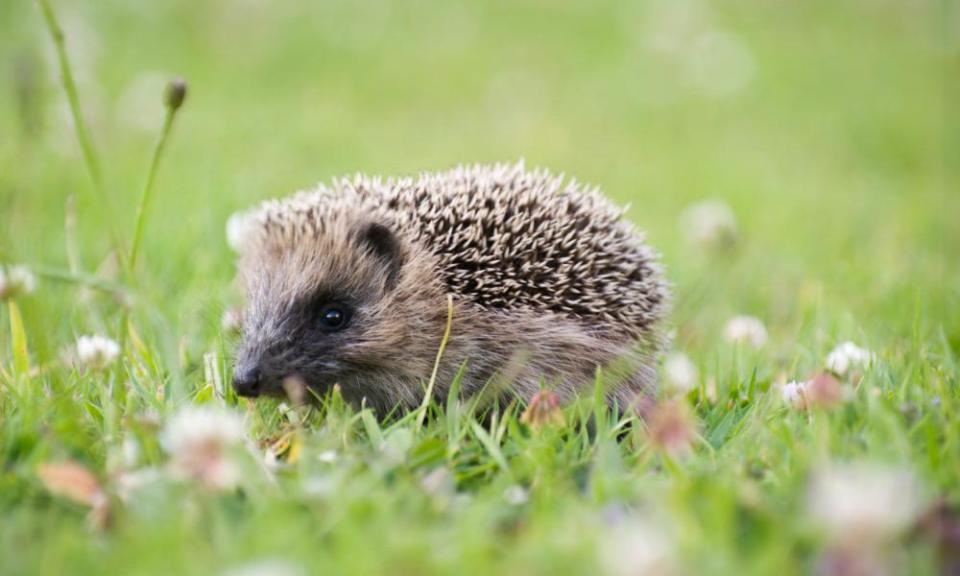Killing machines: humble British hedgehog causes havoc in New Zealand

Consider the hedgehog. Tiny, rotund, bright-eyed and snuffling, they are shampooed for internet videos, fed saucers of milk by children, and have been immortalised by Beatrix Potter’s Mrs Tiggy Winkle. Of all the nocturnal mammals one may encounter poking through the backyard at night, they are surely the most beloved.
But in New Zealand, these small, trundling, spiky creatures are killing machines.
New Zealand is a hedgehog paradise. Whereas in Europe they are hunted by pine martens, foxes and badgers, New Zealand’s hedgehogs have few predators. Unchecked by the food chain, they meander blissfully through forests and gardens, hoovering up an astonishing number of native creatures.
Related: Prickly business: the hedgehog highway that knits a village together
With the exception of a few local bats, New Zealand has no native land-based mammals. Its bird population adapted to this state of affairs – some, like the Kiwi, are flightless, or nest on the ground. When stoats, cats, possums and rats were introduced, they wreaked havoc: crunching down rare insects, killing fresh-hatched chicks, and slurping the eggs of ground-nesting birds.
Hedgehogs are also key culprits. “It’s increasingly coming to light how much damage they can do,” says Nick Foster, a PhD candidate at the University of Otago who is researching hedgehogs. A single, dedicated hedgehog will consume numerous native lizards, bird eggs, and wētā – a kind of large flightless cricket found only in New Zealand. One study found 283 wētā legs in a single hedgehog stomach. “That means in a 24-hour period this hedgehog has guzzled up 60 or so animals,” Foster says. “It’s a banquet.”
To understand the movements of hedgehogs, Foster catches and GPS-tags them. That mission sees him out in the bush at night, equipped with military-grade thermal-imaging headsets.
“You’re chasing these 600-gram animals,” he says. “Walking around at night with these thermal eyepieces – it seems like overkill.” The GPS collars revealed hedgehogs roaming further afield than most would imagine: one was found 2,000 metres up a mountain.
‘The Beatrix Potter effect’
The mission to try to drive hedgehogs from protected habitats is seen as critical in New Zealand. The country is running an ambitious campaign to eradicate introduced predators by 2050, using a mixture of trapping, hunting, and poison. Foster works on Te Manahuna Aoraki, a conservation project that hopes to render 310,000 hectares predator-free, taking advantage of surrounding mountains and natural barriers to create a kind of “island” inland. New Zealand succeeded at eradicating predators on some offshore islands – but doing so on the mainland is much harder.

Adding to the challenge is the PR difficulty of the task. Possums, rats and stoats, with their bared teeth and less-flattering visages, are broadly accepted by the public as nefarious invaders in need of eradication. But hedgehogs are – unfortunately – cute.
Foster says there is “a bit of a psychological barrier” when it comes to hedgehog eradication – a problem he says some researchers dubbed “the Beatrix Potter effect”.
They have long held a special place in the hearts of Pākehā New Zealanders, the ethnic group descended from European immigrants and colonists. Hedgehogs were introduced very deliberately, to remind settlers of the gardens of home. As imports ramped up, people began to lose track of their spiky charges – several escaped from a pigeon loft in Christchurch in the 1890s. They went forth, and multiplied. By 1916, historians write, the population in the wild was “extraordinarily abundant”.
Today, there aren’t clear estimates of just how large hedgehog populations have grown, but there are more in New Zealand than in Britain. The best estimate is around two to four hedgehogs a hectare, eight in optimum conditions. “Think of a big number and it’s probably bigger than that,” says Prof Philip Seddon, director of the Wildlife Management program at University of Otago.
“It has been proposed to ship them all back to the UK,” says Foster. “European hedgehogs aren’t doing so well in Europe. Still in good numbers, but they are declining.”
Related: 'Ghost hedgehogs' on Dorset roads highlight animals' plight
It’s a nice thought, I tell him – a kind of floating metropolis of snuffling, spiked mammals, returning just as they came, on a British ship. More palatable than mass killing. But Foster quickly dampens this line of inquiry. It is “not a feasible idea in terms of biosecurity, logistics or cost,” he says.
The scientists express some regret for the hapless hedgehog: it is, after all, not their fault that they ended up here, thrived, and now pose such a threat. They stress that eradication should be done by appropriate, humane traps, and in a targeted, strategic manner, rather than via haphazard attempts to squash them as roadkill.
“I don’t hate hedgehogs” Foster says. “They’re interesting, smart, charismatic creatures … No one wants to see a hedgehog suffer.”
“We’re not just trying to kill things. We’re trying to make things better for the species around us,” Seddon says. “We have a duty of care to the things that should be in these places.”
Eradicating hedgehogs from an area is actually a more ethical proposition than constant population control, Foster says, which requires killing each generation over again.
“You do it once and you do it right, is the best outcome we can hope for,” he says. “If you remove all the hedgehogs from an area, the killing stops.”

 Yahoo Finance
Yahoo Finance 